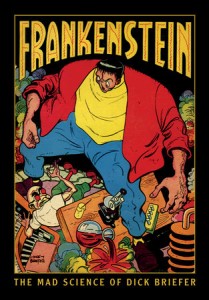
Dick Briefer, author and illustrator
Dark Horse Books
June 9, 2015
Reviewed by Elaine Pascale
“It was already one in the morning; the rain pattered dismally against the panes, and my candle was nearly burnt out, when, by the glimmer of the half-extinguished light, I saw the dull yellow eye of the creature open; it breathed hard….” and sneezed? Charmingly enough, that is what the Frankenstein character of Dick Briefer’s comics first does upon reanimation—he sneezes. This silly and simple act sets the stage for a character that is more loveable than horrific.
The quote included above is from Mary Shelley’s 1816 novel, Frankenstein, which informed Dick Briefer’s Frankenstein for Prize Comics. Dark Horse has collected issues 1 through 7 (published January 1945-May 1947) in Frankenstein: The Mad Science of Dick Briefer. These issues contain a carefree and humorous monster; a monster that is interested in collecting flowers and pets; a very different monster from Mary Shelley’s imagination (and from Briefer’s 1950’s Frankenstein revival). In issue 1, a scientist creates a creature, hoping for a “terrible beast” that will wreak havoc and destruction. His incongruous expectation fosters a parent/child dynamic that is similar (although contrasting) to the one in Shelley’s book: the only relic resurrected from the original, and a motif that dies along with the scientist at the end of that first comic.
For most of the series, Frankenstein helps his town of Mippyville deal with influxes of ghouls, vampires, werewolves, and hybrid creatures. Occasionally he steps out of his native environment to handle mummies in Egypt and the freakish inhabitants of Hollywood. Frankenstein is an unlikely hero, solving problems through his own clumsiness and inability to draw conclusions or make inferences. He is the cartoon version of Herman Munster. Frankenstein contains some childish gags, but also delves into some adult commentary about social class, World War II, and teen fads.
The art work is comprised mostly of bright, eye-catching, primary colors. It is loose and carefree, matching the plots and the main character. It is different from Briefer’s other illustrations which were much more methodical, but would not have been appropriate for Frankenstein despite their impressiveness.
The first seven issues of Dick Briefer’s comic are delightfully entertaining. The stories progress quickly and contain a variety of jokes and punchlines to tickle diverse readers. Dark Horse Archives has done the comic world a great service by breathing new life into the amusing creature that was Briefer’s Frankenstein.
- Comic Review: SPILLBLOOD - November 26, 2024
- Book Review: THE BEASTS OF VISSARIA COUNTY - June 18, 2024
- Book Review: DRAW YOU IN - June 14, 2024
- Book Review: WE’RE NOT OURSELVES TODAY - March 21, 2024
- Book Review: QUESTION NOT MY SALT - February 9, 2024
- Book Review: SPEARFINGER - November 29, 2023
- Book Review: THE CTHULHU HELIX - November 7, 2023
- Book Review: LAUNDRYLEGS - September 22, 2023
- Book Review: WICKED SICK - August 20, 2023
- Book Review: UNSPEAKABLE HORROR 3: DARK RAINBOW RISING - August 15, 2023


